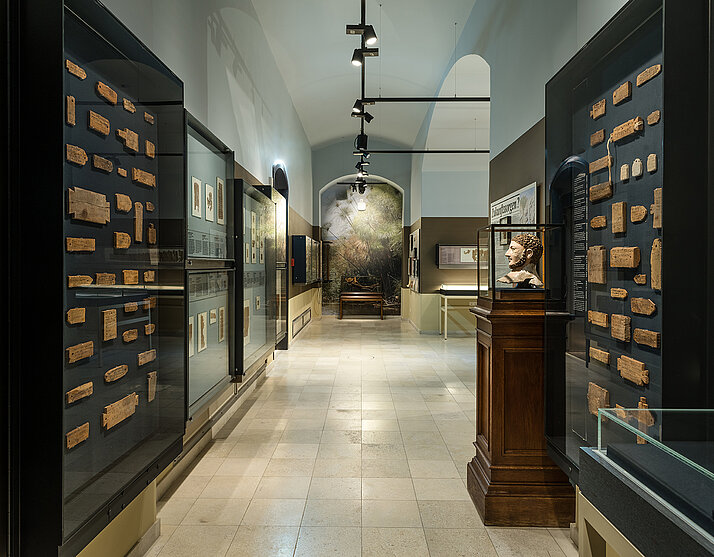In the permanent exhibition 13 themed areas around 400 exhibits are waiting to be discovered:
The Papyrus Museum showcases the papyrus collection of the Austrian National Library. With more than 180,000 objects, it is a UNESCO World Documentary Heritage Site since 2001. The museum offers insight into the fascinating history of the country on the Nile. Let's go on a journey of discovery into the past together.
Did you know that our word 'paper' is derived from the term 'papyrus'? In Egypt itself, people wrote on papyrus for almost 4,000 years. It was not until the late 8th century AD that papyrus was gradually replaced by paper. In pharaonic times, rush brushes were used for writing. From Greek times onwards, reeds were used as writing instruments, which were split and sharpened at one end, similar to modern quills.
In this part of the exhibition you will find a selection of works of ancient Egyptian literature, famous Greek and Roman authors (such as Homer and Cicero) and works of Arabic literature. The importance of literary papyri lies, on the one hand, in the fact that they preserved works that were lost in the hand-written tradition of the European Middle Ages. On the other hand, literary papyri are relevant because of their great age. They are much closer in time to the original texts than the earliest surviving manuscripts of the Western world.
The majority of today's papyrus collection comes from the private collection of the Habsburg Archduke Rainer. He began purchasing papyri and other written documents in 1883 and financed their scholarly processing. The history of the collection thus goes back to the pioneering days of papyrology and is closely connected with the establishment of papyrology as an academic discipline.
Papyri document the diverse economic and occupational branches in agriculture, handicrafts and trade. In the exhibition you will find the most diverse testimonies of agricultural production. From the meticulously kept records of the Nile floods, to leases of agricultural land, to texts that provide information about crafts and trade.
The documentary papyri convey a very lively and multifaceted picture of ancient living conditions. Men and women, old and young, people from all social classes and from different backgrounds have their say; their worries and hardships, their joys and desires become directly tangible for us.
Numerous authentic letters written by ordinary people have been preserved in the papyri. We have selected some letters from our collection with different contents for you: Business letters, letters of recommendation, correspondence between relatives and a letter of condolence.
Ptolemaic kings, Roman emperors and governors, Arab viziers, but also officials at the local level proclaim orders that are sent as copies to all parts of the country. The exhibition shows examples from the Hellenistic, Roman, Byzantine and Arab periods.
The Tabula Peutingeriana is the world's only surviving medieval copy of an ancient road map. It shows the road network in the late Roman Empire from the British Isles across the Mediterranean and the Middle East to India. It is named after one of its previous owners, the humanist Konrad Peutinger, and can be viewed in its entirety as a facsimlie. The Tabula Peutingeriana is included in the UNESCO world register “Memory of the World”.
The mere thought of upcoming official channels or the mention of the tax return that is due makes you shudder. But have you ever received a tax receipt on a potsherd? What do you think the beer tax was in AD 198? How much provisions did a tax collector get for his business trip? You can find out all this and much more in the exhibition. It shows selected administrative, judicial and military documents from a period of around a thousand years.
The exhibition also showcases testimonies from different religions. In addition to ancient Egyptian Isis statuettes, these are primarily documents from the three major book religions: Judaism, Christianity and Islam.
You are searching for a proven remedy against scorpions? You want to know the ingredients of Egyptian toothpaste? Or do you prefer to take a look into your own futur? Magic and medicine were interwoven in ancient Egypt. Discover medical recipes, magical amulettes and pronouncements of oracles.
A highlight in detail: amulet against the sting of a scorpion
When we hear the word "Egypt" today, the first thing that comes to our mind are pyramids and mummies. The Egyptian cult of death and their afterlife have always fascinated people. With our books of the dead, mummy portraits and tomb stelae, immerse yourself in a world beyond the living and deepen your knowledge of the afterlife at our interactive media station.

